- | 5:30 pm
Classic films reel back into the spotlight at IFFI 2023
Restored version of Guide (1965), Haqeeqat (1964), and Bees Saal Baad (1962) are among the timeless classics now screening at IFFI in Goa

Carefully restored classics from India and abroad are premiering at the 54th edition of the International Film Festival of India (IFFI) in its newly introduced Restored Classics section.
In the early years of Indian cinema, particularly during the silent film era and the initial period of the talkies, or motion pictures with synchronized sound, there was limited awareness about the importance of film preservation.
Early films were often made from nitrate or acetate-based materials, which are prone to decay, especially under poor storage conditions.
The original print of the first Indian talkie, Alam Ara (1931), was destroyed due to lack of proper storage conditions, experts said, while pointing out that many films from the early periods of cinema were lost due to the vulnerability of film materials, in addition to neglect and improper storage.
Among the timeless classics now screening at IFFI in Goa are three cinematic gems: Guide (1965) directed by Vijay Anand, Haqeeqat (1964) directed by Chetan Anand, and Bees Saal Baad (1962) directed by Biren Nag.
“An incredible opportunity awaits at #IFFI54 – a chance to delve into the restored Indian classics. Experience these films like never before, with stunning images and clear sound. Immerse yourself in the details of classics that have inspired generations of #IndianCinema,” stated the official Instagram handle of IFFI 2023, accompanied by posters of the films.
View this post on Instagram
“It’s great for us to have our history shown in retrospect to all the coming generations, it’s possible only when something like this happens,” Ketan Anand, filmmaker and son of director Chetan Anand said at a press conference announcing the venture.
Facing the same risk of loss as many films from that era due to damaged celluloid reels, these classics have been preserved through the dedicated restoration efforts of the National Film Heritage Mission (NFHM).
In 2022, the ministry of Information and Broadcasting announced the launch of the world’s largest film restoration project under the NFHM.
The National Film Archive of India (NFAI) set aside a $43.5 million budget to restore over 2,000 films. Selections were made by committees of filmmakers, film historians, and producers, representing various Indian languages.
The restoration involves frame-by-frame digital and semi-automated manual work on both picture and sound, using the best available source material. This includes a 4K scanning of the source negative or print to create .dpx files for digital restoration, where each frame’s scratches, dirt, and abrasions are addressed.
The sound restoration aims to remove pops, hisses, crackles, and distortions from the sound negative digitally.
After restoration, the digital picture files are color graded and balanced to match the film’s original visual aesthetics.
The Restored Classics section will also feature three internationally restored films: Gyorgy Feher’s Twilight, William Friedkin’s The Exorcist Extended Director’s Cut, and Sergei Parajanov’s Shadows of Forgotten Ancestors.
Indian cinema’s century-long history has faced challenges in preservation. With the decline of physical mediums like DVDs and BluRays in the streaming era, there’s a renewed focus on preserving and restoring films to avoid the fate of lost cinematic treasures from earlier generations.













